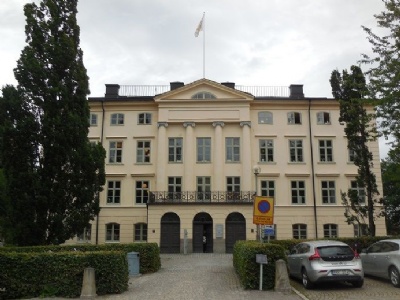Uppsala - SIFR
In the second half of the nineteenth century, academic circles began to discuss races, racial characteristics, and what they were an expression of and what effects they had on states. From these circles a red line was seen between the decay of states and the development of states. Prominent personalities in professions such as economics, psychology, anthropology and medicine gave the discussions a scientific legitimacy that later reached into political circles. But so far, neither in Sweden nor in any other country was there a state racial institute where these ideas could be realized. Discussions were limited to associations and organisations funded by private donations. But this changed when the two chambers of the Swedish parliament in May 1921 decided to establish a state institute for racial biology (abbreviated SIFR). The decision had been preceded by a motion approved by, among others, prime minister, Hjalmar Branting, and the Right-wing leader, Arvid Lindman, all parliamentary parties had, incidentally, agreed to the motion. Thus, concepts such as racial biology, genealogy and heredity became part of Swedish social policy.
SIFR was located in the Dean’s house in central Uppsala, which until 1916 had held Uppsala University’s preschool education. The institute’s first director was the influential and abroad recognized doctor and racial biologist Professor, Herman Lundborg. Lundborg had worked for a long time to ensure that racial biology would be politically anchored and financed by state fundings. The purpose of the institute was to map the racial status and heredity of the Swedish people. Under Lundborg’s leadership, racial biology studies were conducted on about 100,000 Swedes, which in 1927 were compiled in the book Swedish racial studies. Other books that were published were, The Race Biology of the Swedish Lapps: Part I. A comprehensive work on the prehistory of the Sami, their demographics and their future prospects. Lundborg had since 1912 made several trips to Lappland to investigate Sami people on site. But even before the foundation of the institute, Lundborg had published racial biology books, including Swedish folk types and The Swedish Nation. In 1919, Lundborg had also compiled a People’ type exhibition that toured the country, an exhibition that also attracted interest abroad.
From a medical perspective, one was also interested in distinguishing the good genes from the bad genes. It was primarily ”mentally loose” and ”idiots” who were unfortunate to represent bad genes. These were taken into care, locked up in hospitals and often sterilized (sterilization was legalized 1935), all so that their genes would not be spread to the next generation. In this way, it was believed that the bad genes would eventually disappear and that carriers of good genes could reproduce undisturbed and ensure the future of the Swedish people.
Lundborg was also a person who aroused great respect and admiration in foreign racial biology circles. He was frequently hired as a lecturer by foreign universities and made several trips, mainly to Germany, during which he discussed his research and the results he had come up with. Lundborg also had good contacts with German counterparts such as Alfred Plötz, Fritz Lenz, Eugen Fischer, Ernst Rüdin and Hans F.K. Günther. Several of them later made a career in Nazi Germany and Lundborg himself became a respected racial biologist who was often mentioned in Nazi Germany. SIFR also became a model for similar institutes established in other countries, including Germany.
However, SIFR struggled from the outset with financial concerns and Lundborg complained that he did not receive the funds he requested. Nor did the Institute ever get a real foothold in leading political circles and not the development and support that Lundborg hoped for. Lundborg was also a person who, probably to much for his own good, swarmed for Nazi racial teachings. Something that was not always appreciated by politicians or colleagues. One of these critics was Professor Gunnar Dahlberg, who in 1935 came to replace Lundborg as the institute’s head. SIFR then also moved to new premises on Västra Ågatan 24 in central Uppsala. After the Second World War, racial biology as a science began to be questioned, but the institute remained until 1958 when it was transferred to the department of medical genetics at Uppsala University. Forced sterilization was a part of Swedish social policy until 1975 when the law was changed.
Current status: Preserved (2015).
Address: Biskopsgatan 2, 753 10 Uppsala.
Get there: Walk from central Uppsala.
Follow up in books: Stefan, Kühl: The Nazi Connection: Eugenics, American Racism, and German National Socialism (2022).



In 2015, the house is owned by the State real estate agency, which itself uses most premises, other premises are leased to external tenants. Outside the house there is a small information board that tells briefly about the history of the house, but nothing is mentioned about its history as a racial biology institute. This, I think, is a bit strange because Sweden today has made up with its racist history in a way that it should reasonably be completely unproblematic. The house itself has of course undergone some changes over the years, but the house is also classified as a state-owned building memory that makes its architecture and interior design must not be changed without special permission. Which rooms were used for what and who was sitting there noboyd seem to know.
Herman Lundborg died in 1943 and is buried in the family grave at Uppsala’s old cemetery. There lay also a woman named, Maria Lundborg Isaksson (born 1893). This was a woman of Sami descent that Lundborg met during one of his expeditions in northern Sweden and whom he fell in love with. He took her back to Uppsala, gave her a job as a maid at the institute and eventually made her pregnant. In 1927, Mary gave birth to a son named Allan. Lundborg already had two sons (Gunnar 1901 – 1973 and Sune 1903 – 1976) with his wife Thyra, but when Thyra died in 1931 he married Maria in 1936. Maria died in 1968 and their son Allan died in 1991.